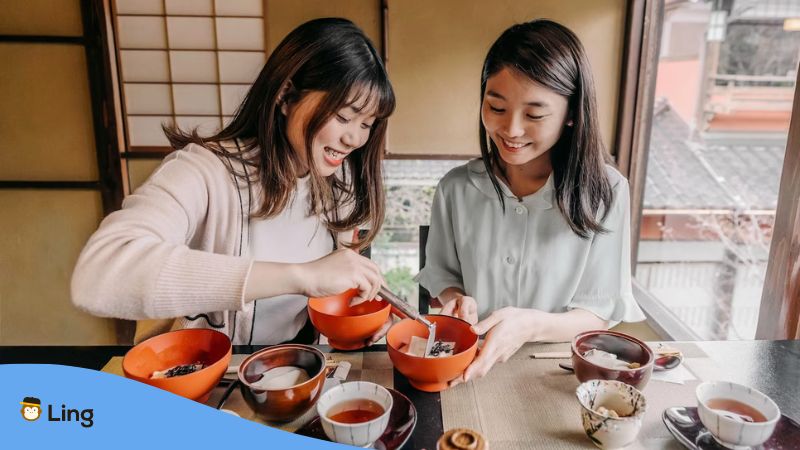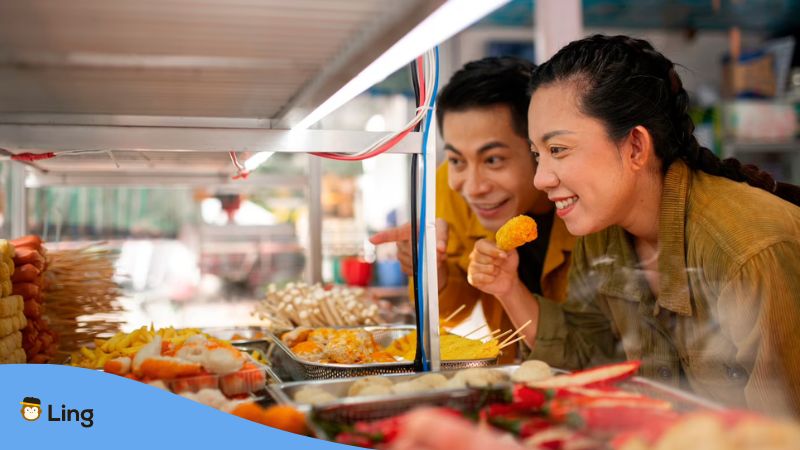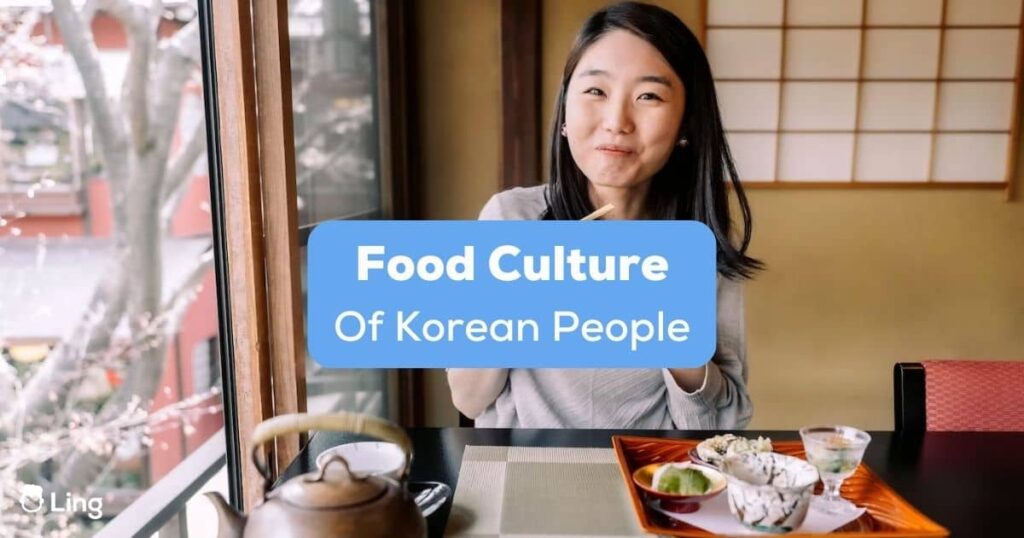Korean food is more than a meal. It’s a story. A story of tradition, history, and values is woven into every bite.
In Korea, “음식 문화” (eumsik munhwa), or food culture, is an intimate part of life. It’s an expression of love, respect, and celebration.
But why is food so vital in Korean culture? It’s simple. It’s not just about eating.
Like learning the Korean language, it’s about connecting.
Stay with us. We’re about to uncover the wonders of the food culture of Korean people, one dish at a time. Let’s begin!
The Roots Of Korean Food Culture
So, where does this rich food culture of South Korea originate? Like a well-cooked stew, it’s a mix of many elements.
History, geography, and religion have all stirred the pot, influencing Korean food culture uniquely.
Influences Of History And Geography
Korea is a small peninsula in East Asia, surrounded by the sea on three sides.
Can you imagine the impact of this unique geography on its cuisine?
Seafood is abundant, and it’s no surprise that it’s a significant part of the Korean diet.
Ever heard of “해물” (haemul)? It refers to seafood in Korean, a star ingredient in many dishes.
But geography doesn’t just mean the sea.
The mountainous terrains of South Korea have influenced the food culture too.
Wild greens and herbs, often called “산나물” (sannamul), are common in Korean meals, thanks to the country’s hilly landscapes.
Impact Of Confucianism And Buddhism
Confucianism and Buddhism have left a mark on Korean food.
For starters, Confucianism emphasizes etiquette, even at the dining table.
Respect for elders is paramount.
Ever wondered why younger Koreans wait for the elders to eat first? Well, that’s Confucianism in action.
On the other hand, Buddhism brought veganism to the table, literally!
Many Korean temples follow a vegan diet, known as “사찰음식” (sachal eumsik) or temple food.
It’s all about simplicity and mindfulness, influencing Korean cuisine beyond the temple walls.

Staples Of Korean Cuisine
You can’t talk about Korean cuisine without mentioning its staples.
Rice, a plethora of side dishes known as ‘banchan,’ and the art of fermentation.
These elements make Korean food what it is today.
The Centrality Of Rice
Rice, or “밥” (bap), is more than just a grain in Korea. It’s the heart of every meal.
In fact, the term “bap” also means “meal” in Korean.
But it’s not just plain white rice.
South Korea boasts a variety of rice dishes, like “볶음밥” (bokkeumbap), or fried rice, and “주먹밥” (jumeokbap), or rice balls from a kneaded glutinous rice flour.
And let’s not forget the ceremonious “떡국” (tteokguk), or rice cake soup, traditionally eaten during the Lunar New Year.
Variety Of Banchan (Side Dishes)
These are the little side dishes that accompany every Korean meal.
From spicy “김치” (kimchi), to savory “잡채” (japchae), to sweet “단호박조림” (danhobak jorim) or braised pumpkin, the variety is staggering!
The best part?
Each banchan plays a unique role in the meal, balancing flavors and textures.
It’s like an orchestra on a plate, with each dish playing its part in harmony.
Unique Fermentation Practices
Fermentation is a culinary technique as old as time, but Koreans have truly mastered it.
Take kimchi, for instance.
This fermented cabbage dish is a Korean staple food, loved for its spicy kick and health benefits.
But it doesn’t stop there.
“된장” (doenjang), or fermented soy sauce and soybean paste, and “고추장” (gochujang), a fermented red chili paste, are two other stars of Korean cuisine.
These fermented Korean foods, known as “장” (jang), are essential in Korean cooking.
They add depth and complexity to Korean dishes and are believed to promote good health too.
Traditional Korean Meals
Now, let’s discuss traditional Korean meals, from the standard composition of a meal to special dishes and the role of food in ancestral rites.
Standard Composition Of A Korean Meal
What’s in traditional Korean food? The answer: balance and harmony.
A standard meal, or “밥상” (bapsang), typically includes cooked rice, soup, and an assortment of banchan.
But there’s more to it.
It’s not just about filling the table. It’s about creating a balance of flavors, textures, and even colors.
Ever noticed the colors in a Korean meal?
Red, green, yellow, white, black; it’s a feast for the eyes!
In Korean food philosophy, these colors represent the five elements of the universe. Pretty deep, right?
This attention to balance and harmony is a testament to the thoughtfulness of Korean cuisine.
Special Dishes For Festivals And Celebrations
Food takes center stage during Korean festivals and celebrations.
Let’s take “설날” (Seollal), or Korean Lunar New Year.
Families gather to make and enjoy “떡국” (tteokguk), a soup made with thinly sliced traditional rice cakes.
It’s believed that eating it adds a year to your age!
Then there’s “추석” (Chuseok), or Korean Thanksgiving.
Here, “송편” (songpyeon) steals the show.
These small rice cakes stuffed with sweet or savory fillings are as tasty as they sound!
Ancestral Rites And Food
Lastly, we can’t discuss traditional Korean meals without mentioning ancestral rites, known as “제사” (Jesa).
Food plays a crucial role here.
Families prepare a spread of Korean dishes that their ancestors enjoyed and offer it to them in a ceremony.
It’s a way of honoring and remembering the deceased, reflecting Koreans’ deep respect for their ancestors.

Dining Etiquette And Social Aspects
Alright, let’s switch gears a bit. Let’s talk about dining etiquette and social aspects of Korean food culture.
Respect And Hierarchy At The Dining Table
Respect is a big deal in Korean culture, and it’s no different at the dining table.
You might notice, for example, that the eldest person at the table is the first to eat.
This is a sign of respect, a practice rooted in Confucian principles of age-based hierarchy.
Ever heard the term “선배” (sunbae)?
It refers to someone senior to you, and in a Korean meal setting, their role is often recognized and respected.
Communal Dining And Sharing Food
Communal dining is another hallmark of the food culture of Korean people.
Have you ever noticed the large dishes in the middle of the table during a Korean meal?
That’s a common sight!
Everyone shares these dishes, which fosters a sense of community and togetherness.
The term “정” (jeong) captures this sentiment of deep affection and bonding that Koreans often associate with shared meals.
So, the next time you’re sharing a bowl of “부대찌개” (budae jjigae) or army stew, remember, you’re also sharing love and warmth!
Drinking Culture And Bonding
Yes, Koreans love their “소주” (soju), but drinking is about more than just the alcohol.
It’s a social activity, a chance to bond and share stories.
It’s common for co-workers to head to a “호프집” (hof jip) or beer house after work to unwind and build camaraderie.
Remember, though, even in a casual setting, respect rules.
For instance, when pouring a drink, the younger or junior person uses both hands to show respect to the older or senior person.
Small details, but they speak volumes about the culture.

Korean Street Food And Modern Trends
Let’s take our taste buds to the streets now. Street food and modern trends, that’s what we’re talking about.
Popular Street Food Items
Street food in Korea is a world of its own. Take “떡볶이” (tteokbokki), for instance. It’s rice cakes in a spicy sauce.
Sounds simple? The taste isn’t.
Then there’s “튀김” (twigim), a sort of Korean tempura.
Think vegetables, squid, and even seaweed, all deep-fried to perfection.
Oh, and let’s not forget “핫도그” (hotteok). Sweet pancakes stuffed with honey, nuts, and cinnamon.
Influence Of Pop Culture On Korean Food
Have you heard of the Korean wave or “한류” (Hallyu)?
It’s brought Korean culture to the world. And food is a big part of it.
Korean BBQ or “고기구이” (gogi-gui), for instance, has become a global sensation.
Who doesn’t love grilling meat at their table, right?
And let’s not forget the “치맥” (chimaek) culture.
It’s a combo of fried chicken and beer that became synonymous with Korean food culture.
Thanks to popular Korean dramas and K-pop music videos!
Fusion Trends And International Influence
Korean cuisine is evolving, blending traditional flavors with international influences.
Ever tried a Korean-Mexican taco? Or a bulgogi pizza?
They’re as delicious as they sound.
This blend of flavors and cuisines is a testament to the dynamism and adaptability of Korean food culture.
Korean Food Culture Related Vocabulary
Language, too, plays a role in the food culture of Korean people.
Let’s learn some Korean words to make the experience even richer.
Each word is a small window into the rich tapestry of Korean food culture.
So, the next time you’re enjoying a Korean meal, remember these words.
Use and savor them, just as you would a delicious dish.
Because language, much like food, is best enjoyed when shared.
Explore The Food Culture Of Korean People With Ling!
Feasting on the food culture of Korean people is an adventure. It’s a rich blend of tradition and flavor. But imagine, what if your language skills matched your taste buds?
Here’s where the Ling app steps in!
It’s an interactive language-learning platform.
It offers real-life context lessons in Korean and 60+ other languages.
With Ling, you’ll do more than taste the culture. You’ll be part of it.
Want to amplify your language and cultural journey?
Download the Ling app from Google Play and App Store.
Add a dash of language learning to your culinary exploration today!



































































